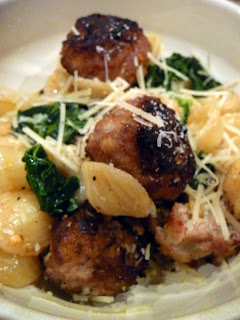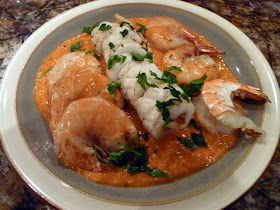A few weeks back, my beautiful Angel and I hosted our wine club dinner. The theme of the Wine Club was "
The F Word," or the recipes of Chef Gordon Ramsay. I really wanted to focus on some of the cooking that inspires the Chef. I have watched a lot of his shows, including
The F Word and
Gordon Ramsay's Great Escapes. I also searched through many of his recipes to make sure each course would have distinct flavors and ingredients.
For the first course, we made Grilled Seafood with a Romesco Sauce. The recipe is heavily influenced by Spanish cuisine. With all of its coastline, from the Bay of Biscay to the Mediterranean Ocean, Spain is particularly well known for its seafood. I have watched many a food show about Spanish cuisine, only to see the fresh seafood, such as sardines, tuna and squid.
I was able to find some very large squid at a local Asian supermarket. These squid were perfect because their thick bodies would stand up well to the grilling. There are a couple drawbacks to using these large squid. First, they are whole squid, which means they have to be cleaned. The best thing to do is to first chop off the head, remove the beak and set aside the tentacles. After that, take a pair of poultry shears (or scissors) and cut down the top of the body very carefully. You have to do your best not to disturb the internal organs. (If you do, you could end up with a big mess.) Once you have cut down the length of the body, you can remove the internal organs and everything else until you have a large squid steak. You should then score the inside of the squid to make a hatch-like pattern. This helps with the second problem. The large squid tend to be tougher and a little chewier than the smaller ones that you usually find in a grocery store. It is said that scoring the squid helps to make the large squid more tender to eat.
As for the other principal component, romesco sauce originated in the Catalonian city of Tarragona. It is said that local fishermen made the sauce to be served with their catch. The principal ingredients of the sauce -- roasted peppers, almonds, vinegar and olive oil -- are combined to produce a sauce that is not only perfect for seafood, but also works with any other protein (especially chicken or pork). Romesco sauce even goes well with just some crusty, rustic bread.
Overall, this recipe produced a very good start to our wine club dinner. While it may not have reached the standards of a Michelin star chef like Chef Ramsay, I think it both the flavors and the plating were fairly good for me.
GRILLED SEAFOOD WITH A ROMESCO SAUCE
Recipe from Gordon Ramsay's Cookery Course
Serves 4
Ingredients (for the seafood):
4 medium to large squid, prepared and cleaned
12 king prawns, shell on
2 tablespoons of parsley, chopped (for garnish)
Ingredients (for the romesco sauce):
2 red peppers
1 thick slice of ciabatta or farmhouse white bread,
crusts removed and torn into chunks
Olive oil
3 garlic cloves, peeled and roughly chopped
3 vine ripe tomatoes (like plum) on the vine
1 teaspoon smoked paprika
4 tablespoons of blanched almonds, toasted
and roughly chopped
1 lemon, juiced
1-2 tablespoons of sherry vinegar
Sea salt, to taste
Ground black pepper, to taste
Directions:
1. Make the romesco sauce. Heat a grill until very hot. Put the peppers on a foil lined baking tray and place under the grill. Cook for 5 minutes turning regularly until he skin is blackened and blistered all over. Transfer to a bowl and set aside to cool.
2. Continue making the romesco sauce. Cook the bread chunks for 2 minutes in a small frying pan with a dash of oil, then add the garlic and cook for a further minute until the garlic is tender and the bread toasted. By this stage, the peppers should have cooled and it will be easy to peel and rub off the charred skins. Peel, deseed and roughly chop them, then place in a blender. Roughly chop the tomatoes and add to the peppers with the bread and garlic. Blitz to form a rough paste.
3. Continue making the romesco sauce. Add the smoked paprika, chile flakes, almonds, lemon juice, vinegar and a pinch of salt and pepper to the blender and blitz until well mixed. Taste and adjust the seasoning. With the motor running, slowly pour in 6 tablespoons of olive oil. Taste and adjust the seasoning again if necessary. Allow the sauce to come to room temperature and stir well before serving.
4. Grill the seafood. Heat a griddle pan over high heat until hot. Lightly score one side of the squid in a diamond pattern before cutting into strips. Toss the prawns and squid together in a little olive oil and season with a little salt and pepper. Place the prawns on the hot griddle and cook for 2 1/2 to 3 minutes. Starting diamond side up, cook the squid for about 1 minute on each side. Leave it to curl up and give it a furhter minute until just cooked.
5. Plate the dish. Serve the seafood hot, garnished with parsley, and with the romesco pepper sauce alongside.
ENJOY!





































